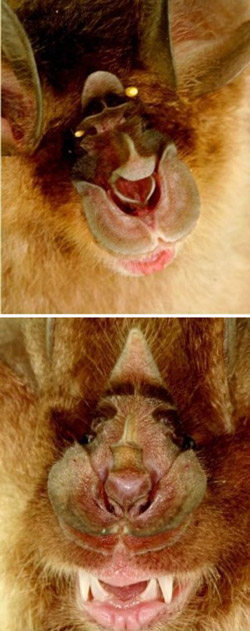The Sound of a Furrowed Brow
Bats’ bizarrely wrinkled, folded, and grooved faces improve their sonar in some way, researchers have long presumed. Now, in the 24 November PRL, a team has shown precisely how one such facial feature works. Computer modeling shows that when a bat emits sound from its nostrils, grooves on its face resonate like empty Coke bottles and direct different frequencies in different directions. The purpose of the sound patterns is unclear, but they might help the animal navigate or find prey.
Bats are famous for their keen ability to bounce high-frequency sound off objects and “see” in the dark. Two groups with the most sophisticated sonar, called horseshoe bats and leaf-nosed bats, also boast some of the strangest-shaped faces. Unlike other bats that emit sonar from their mouths, these bats shoot it from their nostrils, which are surrounded by conspicuous structures called noseleaves. The structures include horn-like protrusions, grooves, and pockets that vary wildly between species. Despite all the attention to the description of noseleaves, researchers have done only a couple of crude studies suggesting that these facial features shape bats’ sonar. But no one has determined the physical mechanisms that allow specific facial features to affect the sonar in specific ways.
Qiao Zhuang and Rolf Müller of Shandong University in Jinan, China, have now shown precisely how one of bats’ facial features can shape their sonar beams. They used three-dimensional scanning to capture the shape of the noseleaf on the rufous horseshoe bat and analyzed it with computer simulation methods often used for investigating the sound patterns from home stereo systems.
The bats emit pulses of sound that start around 60 kilohertz (kHz), quickly ramp up to a constant frequency around 80 kHz for most of the pulse, then drop back to 60 kHz at the end. Zhuang and Müller found that 60 kHz sound, but not 80 kHz, resonated strongly in two horizontal grooves along the top of the noseleaf. These grooves act as open-ended resonating cavities that can enhance certain frequencies of sound–just as blowing across the top of an open soda bottle can make a deep resonant tone.
Because of the grooves’ resonance, the noseleaf directs 60 kHz sound differently than 80 kHz sound, Zhuang and Müller found. The higher frequency is focused in an oval spot straight ahead of the bat, whereas the lower frequency spreads out mostly in a wider oval, with a portion of the sound directed upward. When the team filled in the grooves on the virtual bat, the two frequencies focused in very similar patterns.
Müller says this study shows that specific features on the noseleaf cause different frequencies of sonar to spread in different spatial patterns. “If you would like to think of the bat looking at the world with an ultrasonic flashlight,” he says, this study suggests bats use “an entire array of flashlights, each shining a spotlight of different size, shape, and position on its surroundings.”
Bats are known to use several complex tricks to keep their bearings, and to identify and pursue flying insects, says Gareth Jones, who studies bat acoustics at the University of Bristol in England. The differing spatial patterns for different frequencies might be another tool, he says, but only research on real bats can determine just how this tool is used. The new report “certainly opens up routes for nice experimental tests,” says Jones, such as temporarily filling in the grooves with some substance and looking for changes in the bats’ behavior.
–Mason Inman
Mason Inman is a freelance science writer in San Francisco.





